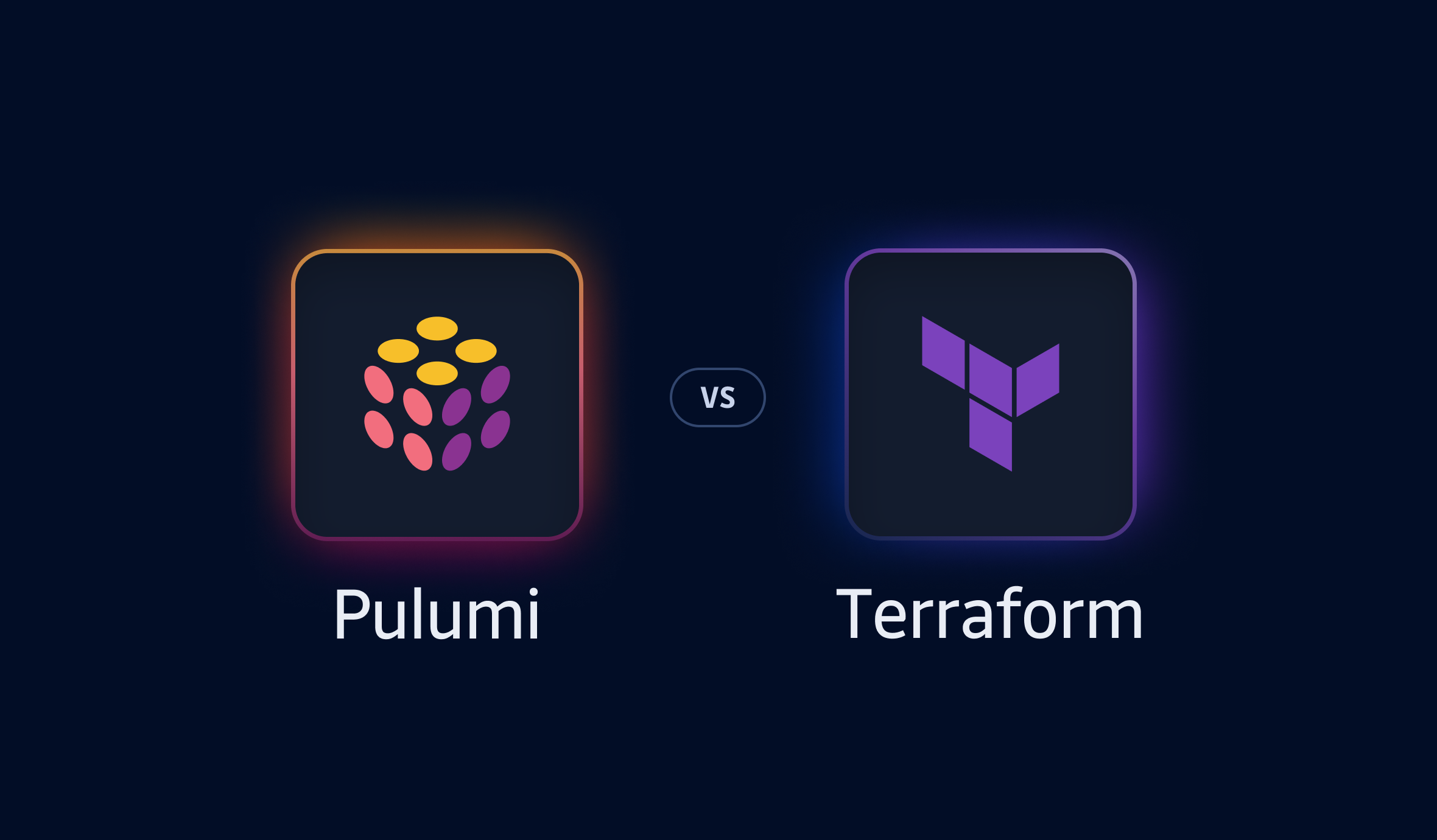Table of Contents
As businesses increasingly shift toward multi-cloud strategies, managing infrastructure efficiently across various platforms becomes a priority. Infrastructure as Code (IaC) tools like Terraform and Pulumi are designed to help you automate, deploy, and manage cloud resources, reducing manual configurations and streamlining operations. Both tools excel at supporting multiple cloud platforms, but they take distinct approaches in managing infrastructure.
This in-depth review provides insights into the strengths, use cases, and business implications of Terraform and Pulumi, complete with technical examples, industry survey comparisons, and recommendations for businesses based on simplicity, scalability, and team structure.
Terraform Overview
Terraform, developed by HashiCorp, has become synonymous with Infrastructure as Code (IaC) due to its extensive provider ecosystem and robust support for multi-cloud environments. Using HCL (HashiCorp Configuration Language), users can define infrastructure declaratively—stating the desired final state—and let Terraform handle the rest.
Key Features:
- Declarative Configuration: You specify the end state, and Terraform determines the necessary steps to reach it.
- Provider Ecosystem: Supports over 100+ cloud providers, including AWS, Azure, GCP, and many third-party services.
- State Management: Keeps track of current infrastructure using a state file, ensuring that incremental changes are applied accurately.
Technical Example (Terraform Configuration Snippet):
In this simple example, Terraform is instructed to provision an AWS EC2 instance in the “us-west-2” region with the specified Amazon Machine Image (AMI) and instance type. Terraform takes care of ensuring this infrastructure is correctly provisioned, updating the state file with every change.
Business Insights:
- Simplicity: Terraform’s declarative nature makes it easier for larger teams and DevOps to maintain complex infrastructures across multiple cloud providers. You simply define what you need, and Terraform handles the “how.”
- Scalability: As a mature tool, Terraform excels in large-scale, multi-cloud deployments. It’s commonly used by businesses to orchestrate infrastructure that spans hundreds of virtual machines, databases, and network configurations.
Interested about a visual learning? Watch this quick 15min tutorial from TechWorld with Nana, where she explains the core principles and foundations of Terraform:
Pulumi Overview
Pulumi is a newer player in the IaC space but stands out by allowing developers to define infrastructure using general-purpose programming languages such as Python, JavaScript, Go, and TypeScript. This imperative approach gives developers more flexibility and control over infrastructure logic, allowing for more complex workflows.
Key Features:
- Imperative Programming: Define infrastructure using traditional programming constructs like loops, functions, and conditionals.
- Multi-Language Support: Developers can use familiar languages, integrating IaC workflows into standard development processes.
- Multi-Cloud Support: Like Terraform, Pulumi supports AWS, Azure, Google Cloud, and many other services, making it suitable for multi-cloud infrastructures.
Technical Example (Pulumi Configuration Snippet – Python):
This Python-based Pulumi example mirrors the Terraform example but with more flexibility. Pulumi allows you to integrate advanced logic like loops and conditionals, which is particularly helpful for complex or dynamic environments.
Business Insights:
- Developer-Focused: Pulumi’s approach appeals to organizations where developers play a more significant role in infrastructure management. If your team is already familiar with programming languages like Python or TypeScript, adopting Pulumi may reduce the learning curve.
- Complex Logic Handling: Pulumi shines when you need to apply more complex logic to infrastructure—such as dynamically scaling resources based on load. This flexibility is a big advantage for businesses with rapidly evolving infrastructure needs.
Watch another video of TechWorld with Nana on Pulumi to understand the integrations of it:
Head-to-Head Comparison: Terraform vs. Pulumi
| Feature | Terraform | Pulumi |
|---|---|---|
| Language | HCL (declarative) | Python, JavaScript, TypeScript, Go, C# (imperative) |
| Ease of Learning | Declarative, but requires learning HCL | Easier for developers familiar with popular languages |
| Modularity | Strong module system | Leverages language constructs like functions, classes |
| State Management | Built-in, local or remote (Terraform Cloud) | Built-in, with managed cloud options (Pulumi Service) |
| Provider Support | Extensive, mature ecosystem across clouds | Growing ecosystem, covering major clouds |
| Community and Documentation | Large, mature community | Smaller community but growing fast |
| Complexity Handling | Great for declarative workflows | Better for dynamic, programmatic workflows |
| Cost | Free, enterprise version available | Free for open-source, premium for managed state |
| Simplicity | Clear, declarative approach ideal for DevOps | Developer-friendly for those comfortable with code |
Industry Survey Insights
According to a 2024 DevOps Tools Survey conducted by CNCF, Terraform continues to be the most widely adopted IaC tool, used by over 65% of surveyed organizations. Pulumi, while still growing, is favored by about 15% of teams—particularly in developer-driven environments where flexibility in infrastructure logic is paramount.
- Terraform is favored in more traditional DevOps or enterprise environments where teams are responsible for large-scale, multi-cloud deployments.
- Pulumi is gaining traction among developer-focused teams, particularly in tech startups and SaaS businesses that require fast iteration and complex logic in infrastructure.
Business Insights:
- Terraform is ideal for organizations prioritizing stability, scalability, and existing DevOps workflows. Its modular nature, paired with provider maturity, makes it the go-to for large enterprises handling complex cloud environments.
- Pulumi is better suited for businesses looking to integrate development and infrastructure workflows more tightly, especially when infrastructure needs to be treated as part of a broader software development process.
Best Recommendation Based on Simplicity and Business Needs
- For Simplicity and Established Workflows: If your team already has a well-established DevOps workflow or if you are managing large-scale infrastructure with a focus on stability and modularity, Terraform is the ideal choice. Its declarative syntax simplifies infrastructure management, and it benefits from extensive community support and mature documentation.
- For Flexibility and Developer-Friendliness: If your team consists of developers who need to integrate infrastructure management into their development processes, or if your infrastructure logic is highly dynamic and complex, Pulumi is the better fit. Pulumi’s ability to leverage general-purpose programming languages makes it easier for developers to work seamlessly across development and operations.
Enough about all the texts, you may be a visual learner just like me, why don’t you just head over to Michael Crilly, and let him explain more in details before you make your choice:
Conclusion: Terraform or Pulumi?
Both Terraform and Pulumi offer robust tools for managing multi-cloud infrastructure, but your choice should depend on your team’s structure, the complexity of your infrastructure, and the ease of integration with your existing workflows.
- Choose Terraform if you want a tried-and-true IaC tool with broad cloud provider support, great modularity, and a declarative approach that’s perfect for DevOps and operations teams.
- Choose Pulumi if your team is developer-heavy and you want to combine infrastructure management with familiar programming languages, allowing you to build more dynamic, logic-based infrastructure solutions.
For more detailed guides on cloud infrastructure management, follow @cerebrixorg on social media!
Franck Kengne
Tech Visionary and Industry Storyteller
Read also
November 19, 2024
November 19, 2024
November 19, 2024

